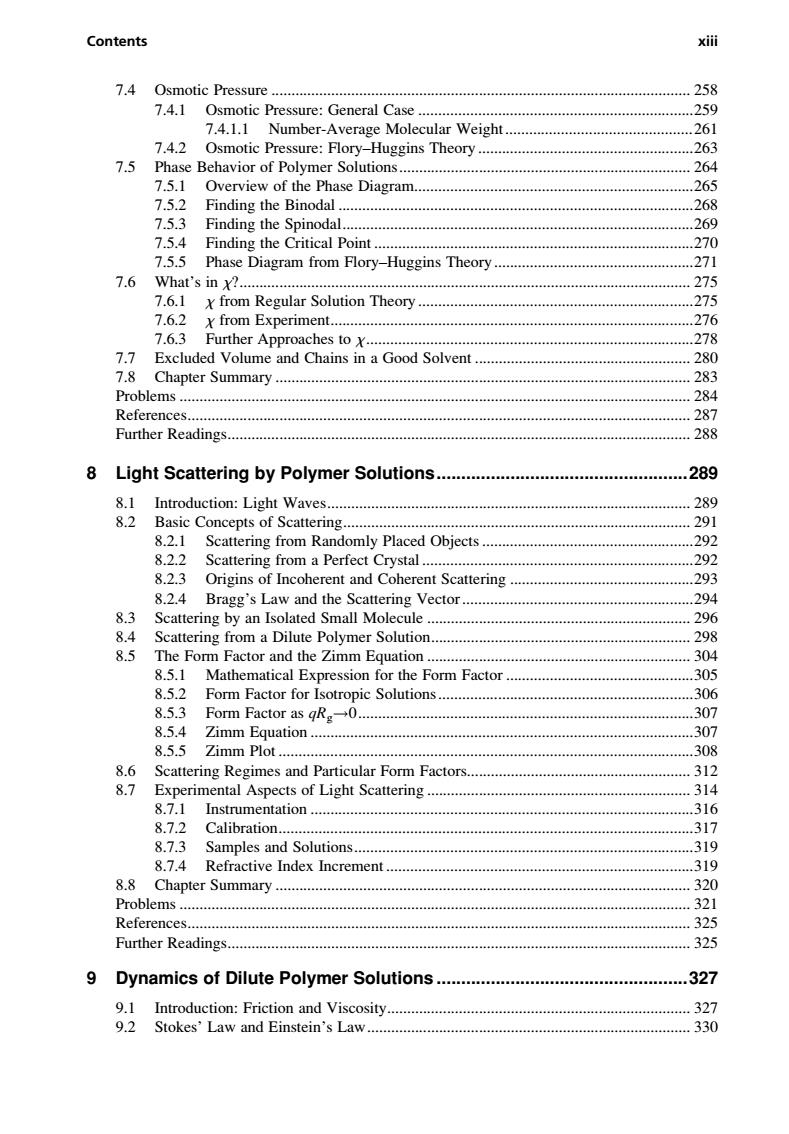
Contents xiii 7.4 Osm tic Pressure… 258 7.4.1 Osmotic Pressure:General Case .259 7.4.1.1 Number-Average Molecular Weight......... .261 7.4.2 Osmotic Pressure:Flory-Huggins Theory263 7.5 Phase Behavior of Polymer Solutions............ 264 7.5.1 Overview of the Phase Diagram............... .265 7.5.2 Finding the Binodal ............. .268 7.5.3 Finding the Spinodal............. .269 7.5.4 Finding the Critical Point............ .270 7.5.5 Phase Diagram from Flory-Huggins Theory.. .271 7.6 What's in x?........ 275 7.6.1 X from Regular Solution Theory.... .275 7.6.2 from Experiment........... .276 7.6.3 Further Approaches to x........ .278 7.7 Excluded Volume and Chains in a Good Solvent 280 7.8 Chapter Summary .. .283 Problems… .284 References..... ,287 Further Readings..... 288 8 Light Scattering by Polymer Solutions..289 8.1 Introduction:Light Waves............... 289 8.2 Basic Concepts of Scattering............ .291 8.2.1 Scattering from Randomly Placed Objects.......................292 8.2.2 Scattering from a Perfect Crystal.292 8.2.3 Origins of Incoherent and Coherent Scattering.............................293 8.2.4 Bragg's Law and the Scattering Vector........ 294 8.3 Scattering by an Isolated Small Molecule.......... ,296 8.4 Scattering from a Dilute Polymer Solution..... ,298 8.5 The Form Factor and the Zimm Equation..... .304 8.5.1 Mathematical Expression for the Form Factor.. .305 8.5.2 Form Factor for Isotropic Solutions.... ..306 8.5.3 Form Factor as qRg→0.… .307 8.5.4 Zimm Equation........ .307 8.5.5 Zimm Plot...... ..308 8.6 Scattering Regimes and Particular Form Factors..... ,312 8.7 Experimental Aspects of Light Scattering. 314 8.7.1 Instrumentation. 316 8.7.2 Calibration...… 317 8.7.3 Samples and Solutions.............. 319 8.7.4 Refractive Index Increment.......... .319 8.8 Chapter Summary. 320 Problems 321 References. 325 Further Readings.… 325 9 Dynamics of Dilute Polymer Solutions.. .327 9.1 Introduction:Friction and Viscosity.... ,327 9.2 Stokes'Law and Einstein's Law. 330
7.4 Osmotic Pressure ......................................................................................................... 258 7.4.1 Osmotic Pressure: General Case .....................................................................259 7.4.1.1 Number-Average Molecular Weight...............................................261 7.4.2 Osmotic Pressure: Flory–Huggins Theory ......................................................263 7.5 Phase Behavior of Polymer Solutions......................................................................... 264 7.5.1 Overview of the Phase Diagram......................................................................265 7.5.2 Finding the Binodal .........................................................................................268 7.5.3 Finding the Spinodal........................................................................................269 7.5.4 Finding the Critical Point ................................................................................270 7.5.5 Phase Diagram from Flory–Huggins Theory..................................................271 7.6 What’s in x?................................................................................................................. 275 7.6.1 x from Regular Solution Theory .....................................................................275 7.6.2 x from Experiment...........................................................................................276 7.6.3 Further Approaches to x..................................................................................278 7.7 Excluded Volume and Chains in a Good Solvent ...................................................... 280 7.8 Chapter Summary ........................................................................................................ 283 Problems ................................................................................................................................ 284 References.............................................................................................................................. 287 Further Readings.................................................................................................................... 288 8 Light Scattering by Polymer Solutions...................................................289 8.1 Introduction: Light Waves........................................................................................... 289 8.2 Basic Concepts of Scattering....................................................................................... 291 8.2.1 Scattering from Randomly Placed Objects .....................................................292 8.2.2 Scattering from a Perfect Crystal ....................................................................292 8.2.3 Origins of Incoherent and Coherent Scattering ..............................................293 8.2.4 Bragg’s Law and the Scattering Vector ..........................................................294 8.3 Scattering by an Isolated Small Molecule .................................................................. 296 8.4 Scattering from a Dilute Polymer Solution................................................................. 298 8.5 The Form Factor and the Zimm Equation .................................................................. 304 8.5.1 Mathematical Expression for the Form Factor ...............................................305 8.5.2 Form Factor for Isotropic Solutions................................................................306 8.5.3 Form Factor as qRg!0....................................................................................307 8.5.4 Zimm Equation ................................................................................................307 8.5.5 Zimm Plot ........................................................................................................308 8.6 Scattering Regimes and Particular Form Factors........................................................ 312 8.7 Experimental Aspects of Light Scattering .................................................................. 314 8.7.1 Instrumentation ................................................................................................316 8.7.2 Calibration........................................................................................................317 8.7.3 Samples and Solutions.....................................................................................319 8.7.4 Refractive Index Increment .............................................................................319 8.8 Chapter Summary ........................................................................................................ 320 Problems ................................................................................................................................ 321 References.............................................................................................................................. 325 Further Readings.................................................................................................................... 325 9 Dynamics of Dilute Polymer Solutions ...................................................327 9.1 Introduction: Friction and Viscosity............................................................................ 327 9.2 Stokes’ Law and Einstein’s Law................................................................................. 330 Hiemenz/ Polymer Chemistry, 2nd Edition DK4670_C000 Final Proof page xiii 5.11.2007 8:20pm Compositor Name: JGanesan Contents xiii
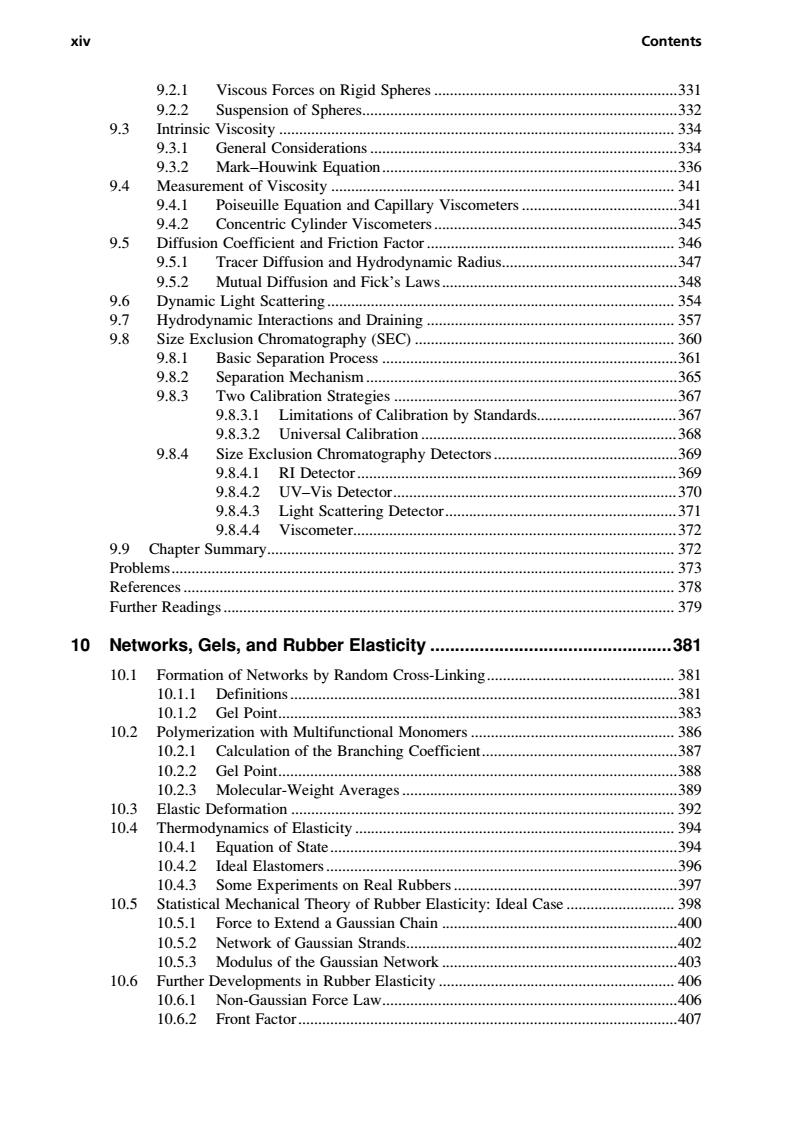
xiv Contents 9.2.1 Viscous Forces on Rigid Spheres .331 9.2.2 Suspension of Spheres..332 9.3 Intrinsic Visc0sity… 334 9.3.1 General Considerations......334 9.3.2 Mark-Houwink Equation...336 9.4 Measurement of Viscosity341 9.4.1 Poiseuille Equation and Capillary Viscometers.................. 341 9.4.2 Concentric Cylinder Viscometers...... 345 9.5 Diffusion Coefficient and Friction Factor............. 44444444444 .346 9.5.1 Tracer Diffusion and Hydrodynamic Radius..................... .347 9.5.2 Mutual Diffusion and Fick's Laws....... 348 9.6 Dynamic Light Scattering............. 354 9.7 Hydrodynamic Interactions and Draining..... 357 9.8 Size Exclusion Chromatography (SEC).... 360 9.8.1 Basic Separation Process........... .361 9.8.2 Separation Mechanism........... 365 9.8.3 Two Calibration Strategies..... ..367 9.8.3.1 Limitations of Calibration by Standards. .367 9.8.3.2 Universal Calibration......... .368 9.8.4 Size Exclusion Chromatography Detectors369 9.84.1 RI Detector..369 9.8.4.2 UV-Vis Detector.370 9.8.4.3 Light Scattering Detector.371 9.8.4.4 Viscometer.............. 0ne2e84444444444a。37 99 Chapter Summary.372 373 门S.44d 378 ...........................00000600000044046064606404 Further Readings. 379 10 Networks,Gels,and Rubber Elasticity....... .381 10.1 Formation of Networks by Random Cross-Linking. 381 10.1.1 Definitions....... .381 10.1.2 Gel Point...… 383 10.2 Polymerization with Multifunctional Monomers... 386 10.2.1 Calculation of the Branching Coefficient... ..387 10.2.2 Gel Point...388 10.23 Molecular-Weight Averages.389 10.3 Elastic Deformation392 10.4 Thermodynamics of Elasticity.394 10.4.1 Equation of State.394 10.4.2 Ideal Elastomers....396 10.4.3 Some Experiments on Real Rubbers............397 10.5 Statistical Mechanical Theory of Rubber Elasticity:Ideal Case.........................398 10.5.1 Force to Extend a Gaussian Chain.......400 10.5.2 Network of Gaussian Strands.................. .402 10.5.3 Modulus of the Gaussian Network...... .403 10.6 Further Developments in Rubber Elasticity...... 406 10.6.1 Non-Gaussian Force Law............... ..406 10.6.2 Front Factor… .407
9.2.1 Viscous Forces on Rigid Spheres .............................................................331 9.2.2 Suspension of Spheres...............................................................................332 9.3 Intrinsic Viscosity ................................................................................................... 334 9.3.1 General Considerations .............................................................................334 9.3.2 Mark–Houwink Equation..........................................................................336 9.4 Measurement of Viscosity ...................................................................................... 341 9.4.1 Poiseuille Equation and Capillary Viscometers .......................................341 9.4.2 Concentric Cylinder Viscometers .............................................................345 9.5 Diffusion Coefficient and Friction Factor .............................................................. 346 9.5.1 Tracer Diffusion and Hydrodynamic Radius............................................347 9.5.2 Mutual Diffusion and Fick’s Laws...........................................................348 9.6 Dynamic Light Scattering ....................................................................................... 354 9.7 Hydrodynamic Interactions and Draining .............................................................. 357 9.8 Size Exclusion Chromatography (SEC) ................................................................. 360 9.8.1 Basic Separation Process ..........................................................................361 9.8.2 Separation Mechanism ..............................................................................365 9.8.3 Two Calibration Strategies .......................................................................367 9.8.3.1 Limitations of Calibration by Standards...................................367 9.8.3.2 Universal Calibration ................................................................368 9.8.4 Size Exclusion Chromatography Detectors ..............................................369 9.8.4.1 RI Detector ................................................................................369 9.8.4.2 UV–Vis Detector.......................................................................370 9.8.4.3 Light Scattering Detector..........................................................371 9.8.4.4 Viscometer.................................................................................372 9.9 Chapter Summary...................................................................................................... 372 Problems.............................................................................................................................. 373 References ........................................................................................................................... 378 Further Readings ................................................................................................................. 379 10 Networks, Gels, and Rubber Elasticity .................................................381 10.1 Formation of Networks by Random Cross-Linking............................................... 381 10.1.1 Definitions .................................................................................................381 10.1.2 Gel Point....................................................................................................383 10.2 Polymerization with Multifunctional Monomers ................................................... 386 10.2.1 Calculation of the Branching Coefficient.................................................387 10.2.2 Gel Point....................................................................................................388 10.2.3 Molecular-Weight Averages .....................................................................389 10.3 Elastic Deformation ................................................................................................ 392 10.4 Thermodynamics of Elasticity ................................................................................ 394 10.4.1 Equation of State.......................................................................................394 10.4.2 Ideal Elastomers ........................................................................................396 10.4.3 Some Experiments on Real Rubbers ........................................................397 10.5 Statistical Mechanical Theory of Rubber Elasticity: Ideal Case ........................... 398 10.5.1 Force to Extend a Gaussian Chain ...........................................................400 10.5.2 Network of Gaussian Strands....................................................................402 10.5.3 Modulus of the Gaussian Network ...........................................................403 10.6 Further Developments in Rubber Elasticity ........................................................... 406 10.6.1 Non-Gaussian Force Law..........................................................................406 10.6.2 Front Factor...............................................................................................407 Hiemenz/ Polymer Chemistry, 2nd Edition DK4670_C000 Final Proof page xiv 5.11.2007 8:20pm Compositor Name: JGanesan xiv Contents
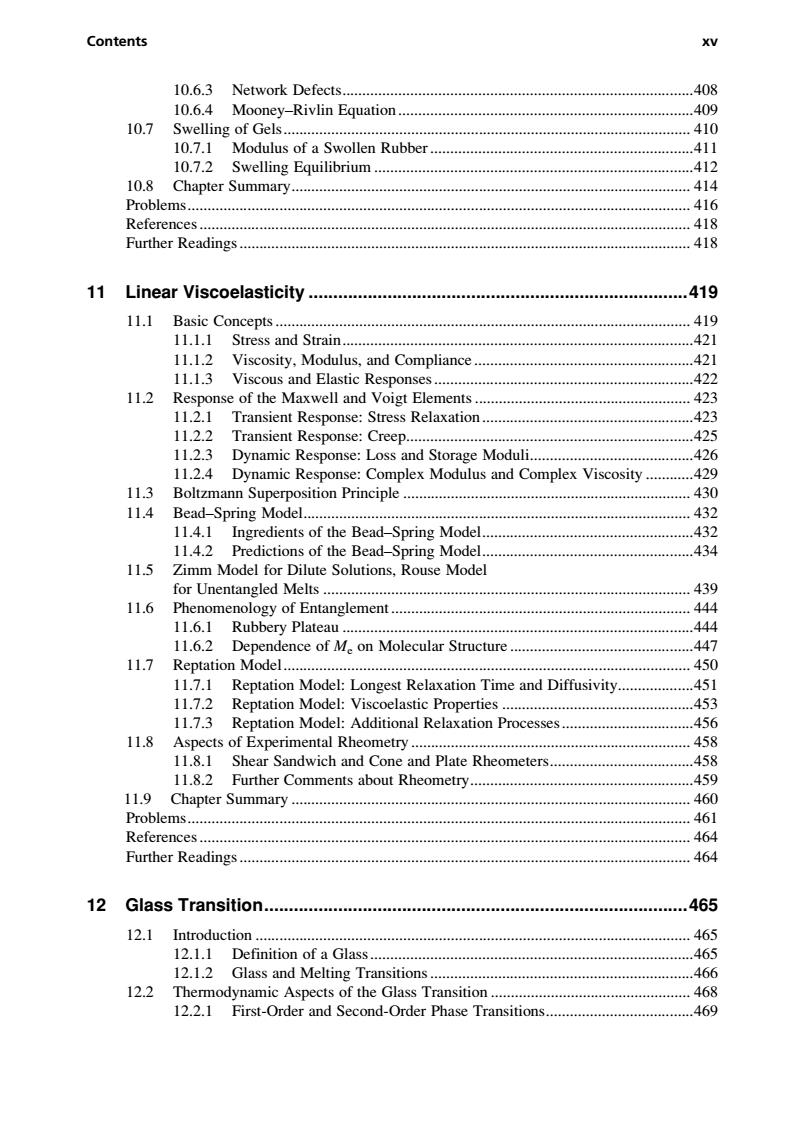
Contents XV 10.6.3 Network Defects...408 10.6.4 Mooney-Rivlin Equation. .409 10.7 10.7.1 Modulus of a Swollen Rubber.....4.1 10.7.2 Swelling Equilibrium................ .412 10.8 Chapter Summary........ 414 Problems.… 416 References.. 418 Further Readings.… 418 11 Linear Viscoelasticity ................ .419 11.1 Basic Concepts… .419 11.1.1 Stress and Strain............ ..421 11.1.2 Viscosity,Modulus,and Compliance421 11.1.3 Viscous and Elastic Responses..422 11.2 Response of the Maxwell and Voigt Elements.423 11.2.1 Transient Response:Stress Relaxation.423 11.22 Transient Response:Creep.45 11.2.3 Dynamic Response:Loss and Storage Moduli...............426 11.2.4 Dynamic Response:Complex Modulus and Complex Viscosity............429 11.3 Boltzmann Superposition Principle.430 11.4 Bead-spring Model432 11.4.1 Ingredients of the Bead-Spring Model............ .432 11.4.2 Predictions of the Bead-Spring Model...... .434 11.5 Zimm Model for Dilute Solutions,Rouse Model for Unentangled Melts. .439 11.6 Phenomenology of Entanglement...................... .444 11.6.1 Rubbery Plateau............ .444 11.6.2 Dependence of M.on Molecular Structure .447 11.7 Reptation Model .450 11.7.1 Reptation Model:Longest Relaxation Time and Diffusivity. …451 11.7.2 Reptation Model:Viscoelastic Properties............ 453 11.7.3 Reptation Model:Additional Relaxation Processes............................456 11.8 Aspects of Experimental Rheometry.458 11.8.1 Shear Sandwich and Cone and Plate Rheometers...............................458 11.8.2 Further Comments about Rheometry.....459 1l.9 Chapter Summary… .460 Problems.… 461 References.. 464 Further Readings............. 464 12 Glass Transition................ ....465 12.1 ntroduction… .465 12.1.1 Definition of a Glass...... ..465 12.1.2 Glass and Melting Transitions.... .466 12.2 Thermodynamic Aspects of the Glass Transition...... .468 12.2.1 First-Order and Second-Order Phase Transitions................. .469
10.6.3 Network Defects........................................................................................408 10.6.4 Mooney–Rivlin Equation ..........................................................................409 10.7 Swelling of Gels...................................................................................................... 410 10.7.1 Modulus of a Swollen Rubber ..................................................................411 10.7.2 Swelling Equilibrium ................................................................................412 10.8 Chapter Summary.................................................................................................... 414 Problems.............................................................................................................................. 416 References ........................................................................................................................... 418 Further Readings ................................................................................................................. 418 11 Linear Viscoelasticity .............................................................................419 11.1 Basic Concepts ........................................................................................................ 419 11.1.1 Stress and Strain........................................................................................421 11.1.2 Viscosity, Modulus, and Compliance .......................................................421 11.1.3 Viscous and Elastic Responses .................................................................422 11.2 Response of the Maxwell and Voigt Elements ...................................................... 423 11.2.1 Transient Response: Stress Relaxation.....................................................423 11.2.2 Transient Response: Creep........................................................................425 11.2.3 Dynamic Response: Loss and Storage Moduli.........................................426 11.2.4 Dynamic Response: Complex Modulus and Complex Viscosity ............429 11.3 Boltzmann Superposition Principle ........................................................................ 430 11.4 Bead–Spring Model................................................................................................. 432 11.4.1 Ingredients of the Bead–Spring Model.....................................................432 11.4.2 Predictions of the Bead–Spring Model.....................................................434 11.5 Zimm Model for Dilute Solutions, Rouse Model for Unentangled Melts ............................................................................................ 439 11.6 Phenomenology of Entanglement ........................................................................... 444 11.6.1 Rubbery Plateau ........................................................................................444 11.6.2 Dependence of Me on Molecular Structure ..............................................447 11.7 Reptation Model...................................................................................................... 450 11.7.1 Reptation Model: Longest Relaxation Time and Diffusivity...................451 11.7.2 Reptation Model: Viscoelastic Properties ................................................453 11.7.3 Reptation Model: Additional Relaxation Processes .................................456 11.8 Aspects of Experimental Rheometry ...................................................................... 458 11.8.1 Shear Sandwich and Cone and Plate Rheometers....................................458 11.8.2 Further Comments about Rheometry........................................................459 11.9 Chapter Summary .................................................................................................... 460 Problems.............................................................................................................................. 461 References ........................................................................................................................... 464 Further Readings ................................................................................................................. 464 12 Glass Transition......................................................................................465 12.1 Introduction ............................................................................................................. 465 12.1.1 Definition of a Glass .................................................................................465 12.1.2 Glass and Melting Transitions ..................................................................466 12.2 Thermodynamic Aspects of the Glass Transition .................................................. 468 12.2.1 First-Order and Second-Order Phase Transitions.....................................469 Hiemenz/ Polymer Chemistry, 2nd Edition DK4670_C000 Final Proof page xv 5.11.2007 8:20pm Compositor Name: JGanesan Contents xv
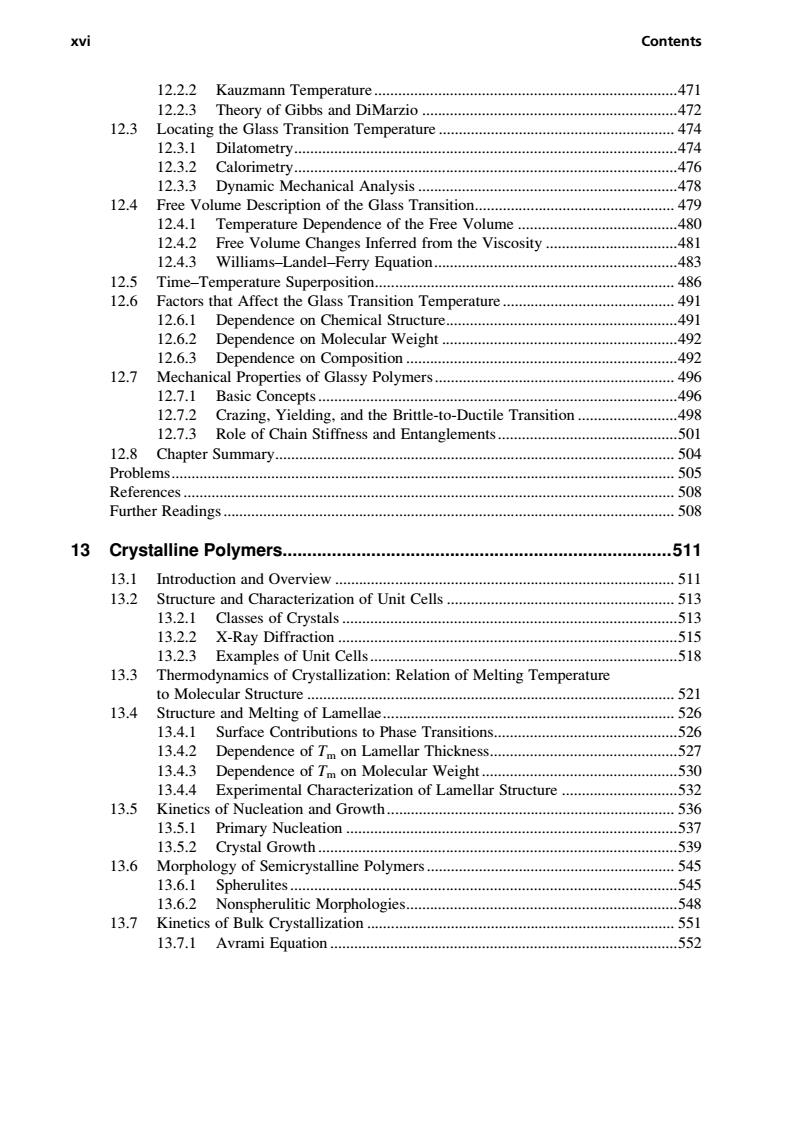
xvi Contents 12.2.2 Kauzmann Temperature.471 12.2.3 Theory of Gibbs and DiMarzio.472 12.3 Locating the Glass Transition Temperature474 123.1 Dilatometry474 12.3.2 Calorimetry.76 12.3.3 Dynamic Mechanical Analysis................... 478 12.4 Free Volume Description of the Glass Transition......... 479 12.4.1 Temperature Dependence of the Free Volume......... 480 12.4.2 Free Volume Changes Inferred from the Viscosity 481 12.4.3 Williams-Landel-Ferry Equation.. 483 12.5 Time-Temperature Superposition................ 486 12.6 Factors that Affect the Glass Transition Temperature.... 491 12.6.1 Dependence on Chemical Structure............ .491 12.6.2 Dependence on Molecular Weight...... .492 12.6.3 Dependence on Composition......... ..492 12.7 Mechanical Properties of Glassy Polymers....... 496 12.7.1 Basic Concepts..... .496 12.7.2 Crazing,Yielding,and the Brittle-to-Ductile Transition. .498 12.7.3 Role of Chain Stiffness and Entanglements....... .501 12.8 Chapter Summary… 504 Problems.… 505 References… 508 Further Readings.… 508 13 Crystalline Polymers.......... ...511 13.1 Introduction and Overview..................... .511 13.2 Structure and Characterization of Unit Cells 513 13.2.1 Classes of Crystals...... .513 13.2.2 X-Ray Diffraction..... .515 13.2.3 Examples of Unit Cells....... .518 13.3 Thermodynamics of Crystallization:Relation of Melting Temperature to Molecular Structure............. 521 13.4 Structure and Melting of Lamellae....... 526 13.4.1 Surface Contributions to Phase Transitions.............. ..526 13.4.2 Dependence of Tm on Lamellar Thickness........ .527 13.4.3 Dependence of Tm on Molecular Weight..................................530 13.4.4 Experimental Characterization of Lamellar Structure.......532 13.5 Kinetics of Nucleation and Growth....................536 13.5.1 Primary Nucleation.537 13.5.2 Crystal Growth..539 13.6 Morphology of Semicrystalline Polymers................. 545 13.6.1 Sphertlites545 13.6.2 Nonspherulitic Morphologies.....548 13.7 Kinetics of Bulk Crystallization........... 551 13.7.1 Avrami Equation..... .552
12.2.2 Kauzmann Temperature ............................................................................471 12.2.3 Theory of Gibbs and DiMarzio ................................................................472 12.3 Locating the Glass Transition Temperature ........................................................... 474 12.3.1 Dilatometry................................................................................................474 12.3.2 Calorimetry................................................................................................476 12.3.3 Dynamic Mechanical Analysis .................................................................478 12.4 Free Volume Description of the Glass Transition.................................................. 479 12.4.1 Temperature Dependence of the Free Volume ........................................480 12.4.2 Free Volume Changes Inferred from the Viscosity .................................481 12.4.3 Williams–Landel–Ferry Equation.............................................................483 12.5 Time–Temperature Superposition........................................................................... 486 12.6 Factors that Affect the Glass Transition Temperature ........................................... 491 12.6.1 Dependence on Chemical Structure..........................................................491 12.6.2 Dependence on Molecular Weight ...........................................................492 12.6.3 Dependence on Composition ....................................................................492 12.7 Mechanical Properties of Glassy Polymers ............................................................ 496 12.7.1 Basic Concepts ..........................................................................................496 12.7.2 Crazing, Yielding, and the Brittle-to-Ductile Transition .........................498 12.7.3 Role of Chain Stiffness and Entanglements.............................................501 12.8 Chapter Summary.................................................................................................... 504 Problems.............................................................................................................................. 505 References ........................................................................................................................... 508 Further Readings ................................................................................................................. 508 13 Crystalline Polymers...............................................................................511 13.1 Introduction and Overview ..................................................................................... 511 13.2 Structure and Characterization of Unit Cells ......................................................... 513 13.2.1 Classes of Crystals ....................................................................................513 13.2.2 X-Ray Diffraction .....................................................................................515 13.2.3 Examples of Unit Cells.............................................................................518 13.3 Thermodynamics of Crystallization: Relation of Melting Temperature to Molecular Structure ............................................................................................ 521 13.4 Structure and Melting of Lamellae......................................................................... 526 13.4.1 Surface Contributions to Phase Transitions..............................................526 13.4.2 Dependence of Tm on Lamellar Thickness...............................................527 13.4.3 Dependence of Tm on Molecular Weight .................................................530 13.4.4 Experimental Characterization of Lamellar Structure .............................532 13.5 Kinetics of Nucleation and Growth........................................................................ 536 13.5.1 Primary Nucleation ...................................................................................537 13.5.2 Crystal Growth ..........................................................................................539 13.6 Morphology of Semicrystalline Polymers .............................................................. 545 13.6.1 Spherulites .................................................................................................545 13.6.2 Nonspherulitic Morphologies....................................................................548 13.7 Kinetics of Bulk Crystallization ............................................................................. 551 13.7.1 Avrami Equation .......................................................................................552 Hiemenz/ Polymer Chemistry, 2nd Edition DK4670_C000 Final Proof page xvi 5.11.2007 8:20pm Compositor Name: JGanesan xvi Contents
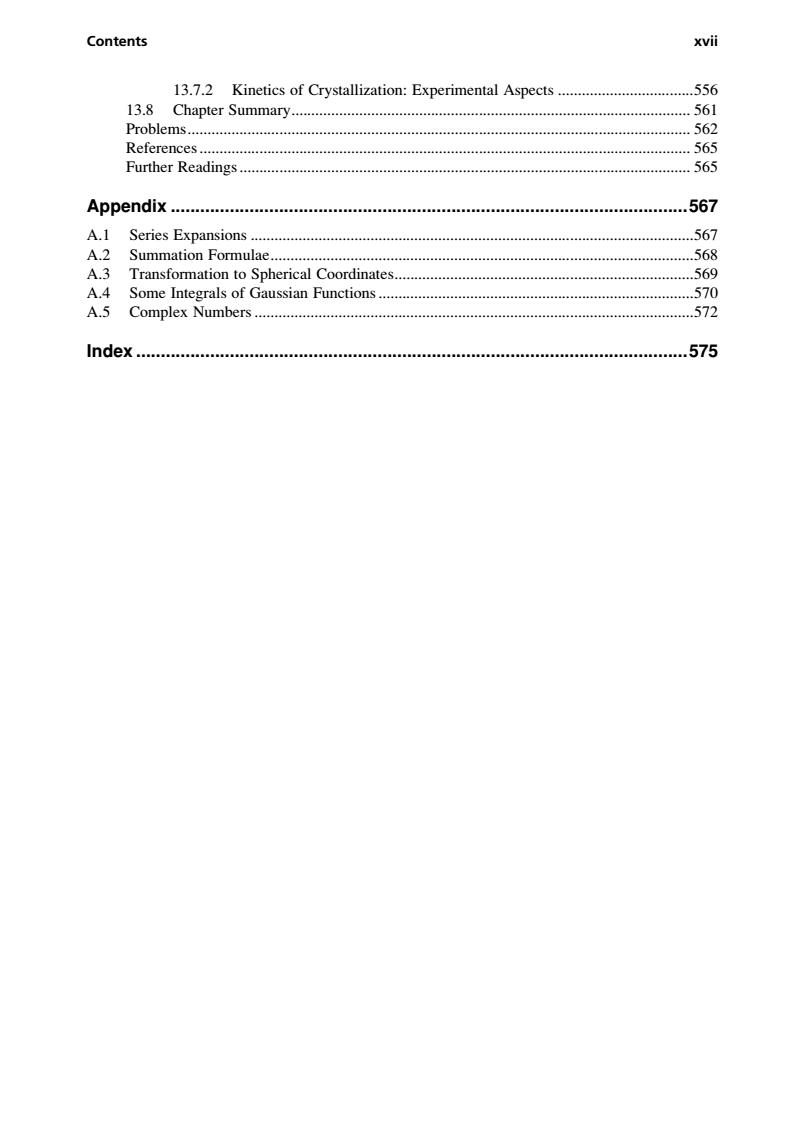
Contents xvii 13.7.2 Kinetics of Crystallization:Experimental Aspects556 13.8 Chapter Summary. 561 References… 565 Further Readings.… .565 Appendix 567 A.1 Series Expansions..... 567 A.2 Summation Formulae............... 568 A.3 Transformation to Spherical Coordinates.... 569 A.4 Some Integrals of Gaussian Functions............... 570 A.5 Complex Numbers hdey............................... 575
13.7.2 Kinetics of Crystallization: Experimental Aspects ..................................556 13.8 Chapter Summary.................................................................................................... 561 Problems.............................................................................................................................. 562 References ........................................................................................................................... 565 Further Readings ................................................................................................................. 565 Appendix .........................................................................................................567 A.1 Series Expansions ...............................................................................................................567 A.2 Summation Formulae..........................................................................................................568 A.3 Transformation to Spherical Coordinates...........................................................................569 A.4 Some Integrals of Gaussian Functions ...............................................................................570 A.5 Complex Numbers ..............................................................................................................572 Index ................................................................................................................575 Hiemenz/ Polymer Chemistry, 2nd Edition DK4670_C000 Final Proof page xvii 5.11.2007 8:20pm Compositor Name: JGanesan Contents xvii